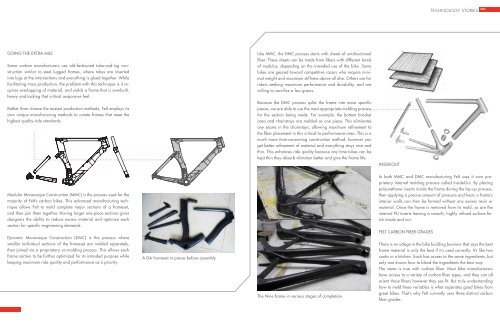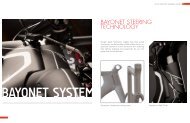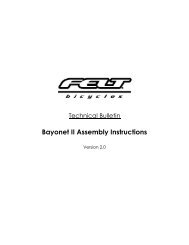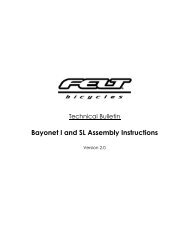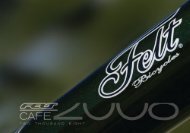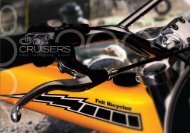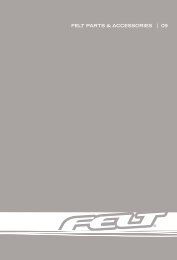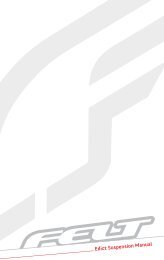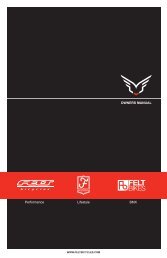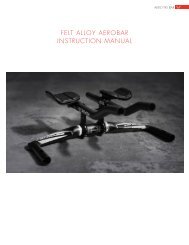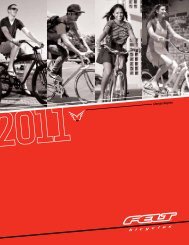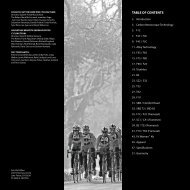Create successful ePaper yourself
Turn your PDF publications into a flip-book with our unique Google optimized e-Paper software.
TECHNOLOGY STORIES2013GOING THE EXTRA MILESome carbon manufacturers use old-fashioned tube-and-lug constructionsimilar to steel lugged frames, where tubes are insertedinto lugs at the intersections and everything is glued together. Whilefacilitating mass production, the problem with this technique is it requiresoverlapping of material, and yields a frame that is overbuilt,heavy and lacking that critical responsive feel.Rather than choose the easiest production methods, <strong>Felt</strong> employs itsown unique manufacturing methods to create frames that meet thehighest quality ride standards.Like MMC, the DMC process starts with sheets of unidirectionalfiber. These sheets can be made from fibers with different levelsof modulus, depending on the intended use of the bike. Somebikes are geared toward competitive racers who require minimalweight and maximum stiffness above all else. Others are forriders seeking maximum performance and durability, and arewilling to sacrifice a few grams.Because the DMC process splits the frame into more specificpieces, we are able to use the most appropriate molding processfor the section being made. For example, the bottom bracketarea and chainstays are molded as one piece. This eliminatesany seams in the chainstays, allowing maximum refinement tothe fiber placement in this critical-to-performance area. This is amuch more time-consuming construction method, however youget better refinement of material and everything stays nice andthin. This enhances ride quality because any time tubes can bekept thin they absorb vibration better and give the frame life.INSIDEOUTModular Monocoque Construction (MMC) is the process used for themajority of <strong>Felt</strong>’s carbon bikes. This advanced manufacturing techniqueallows <strong>Felt</strong> to mold complete major sections of a frameset,and then join them together. Having larger one-piece sections givesdesigners the ability to reduce excess material and optimize eachsection for specific engineering demands.Dynamic Monocoque Construction (DMC) is the process wheresmaller individual sections of the frameset are molded separately,then joined via a proprietary co-molding process. This allows eachframe section to be further optimized for its intended purpose whilekeeping maximum ride quality and performance as a priority.A DA frameset in pieces before assemblyThe Nine frame in various stages of completion.In both MMC and DMC manufacturing <strong>Felt</strong> uses it own proprietaryinternal molding process called InsideOut. By placingpolyurethane inserts inside the frame during the lay-up process,then applying a precise amount of pressure and heat, a frame’sinterior walls can then be formed without any excess resin ormaterial. Once the frame is removed from its mold, so are theinternal PU inserts leaving a smooth, highly refined surface finishinside and out.<strong>FELT</strong> <strong>CARBON</strong> <strong>FIBER</strong> GRADESThere is an adage in the bike building business that says the bestframe material is only the best if it’s used correctly. It’s like twocooks in a kitchen. Each has access to the same ingredients, butonly one knows how to blend the ingredients the best way.The same is true with carbon fiber. Most bike manufacturershave access to a variety of carbon fiber types, and they can allorient those fibers however they see fit. But truly understandinghow to meld these variables is what separates good bikes fromgreat bikes. That’s why <strong>Felt</strong> currently uses three distinct carbonfiber grades.


